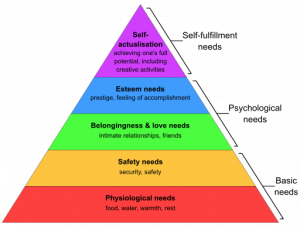5.3 Compulsive eating, sexual behaviours, & internet use

The definition of “behavioural addictions has been recently expanded by health researchers in Canada, including CAMH, to encompass any behaviour characterized by (i) a feeling of tension or arousal before the action, (ii) gratification and/or relief at the time of executing the act, (iii) an inability to resist an urge or drive even against great obstacles or dangers, and (iv) the absence of consideration for the negative consequences that may affect family, friends, or work,[1] though this is not yet reflected in the DSM-V. While it is important to note that only gambling has made it to the DSM-V, behavioural addictions is a field in which there are many studies currently taking place. As we do not look at any of the disorders in this text in a binary (as neither black or white, positive nor negative), we must use an open approach to exploring the behaviours listed below. For this work there is a short list of behaviours that have been associated with addictions.
Compulsive Eating
Food is a basic physiological need and we need food to survive. Based on Maslow’s hierarchy of needs below, there are many other needs from physiological to safety all the way to self-actualization. What role does food play in your life? Have you ever participated in a gathering with friends of family with food? Food has an important place in ceremony in Canada, from holiday celebrations to graduations to religious ceremonies and everywhere in between. Knowing the role that food has, as a basic need, and the way we use food, it is not surprising that our relationship with food is complicated. When does food become a problem? Have you ever used food to cope with a loss, stress, a difficult time? Some individuals use food as a coping mechanism, like the way an individual would use a substance. While the biological reaction a body has is different to food than to a substance, it has increasingly been suggested that some eating habits, such as the uncontrolled intake of high-calorie food rich in sugar and fat can be referred to as “food addiction” (Sauvaget et al., 2015).
5.3A Activities
- Identify risk factors associated with “food addiction”
- Identify harms associated with “food addiction”
- Identify programs that support individuals with food related addictions in your community.
- Research an intervention that targets a specific demographic for “food addiction.”
- Share your top 3 learnings.
Compulsive Sexual Behaviours (CSB)
What is Compulsive Sexual Behaviour (CSB)? CSB is “characterized by recurrent and intense normophiliac or paraphilic sexually arousing fantasies, sexual urges, and behaviors that cause clinically significant distress in social, occupational, or other important areas of functioning”.[2] The behaviours can include “Masturbation; Pornography; Sexual Behavior with Consenting Adults; Cybersex; Telephone Sex; Strip Clubs; or other” (p. 254). Like other disorders, CSB has compulsions, which manifest in sexual behaviour; “the sexual activity while initially resisted, are enacted to reduce anxiety and are often followed by feelings of distress” (p. 255). It can affect all genders; however, research currently suggests those who identify as male report CSB more frequently (p. 255). There are similarities between CSB and substance abuse, for example “withdrawal symptoms such as depression, anxiety, rumination, and guilt related to a reduction of sexual activities, as well as difficulties to stop or reduce the frequency of sexual activities” (p. 255). As other researchers in this area have noted, “excessive sex in itself is not necessarily problematic” (Griffiths, 2016, p. 2017); it is when the behaviour becomes problematic for the individual that we can consider CSB as a problem. The research on CSB as an addiction or disorder is not clear, therefore for the purpose of this text, let us examine some of the risks associated with CSB and address harm reduction interventions.
5.3B Activities
- What is the age of consent in Nova Scotia?
- What are the risks associated with many sexual partners?
- How can you reduce these risks?
- How can you ensure appropriate boundaries when working with individuals who live with compulsive sexual behaviours?
- What community agencies can provide information and support for reducing harms associated with compulsive sexual behaviours?
When it comes to sexual activity and sexual behaviours in Canada, we are bombarded with messages daily. What is normal? What is excessive? What is appropriate, particularly when it comes to sex and gender. We are now in the age of the #MeToo movement, which has been a reckoning of sorts for people with many individuals in positions of power being investigated for sexualized violence.
5.3C Activities
- Read the following article: https://www.nytimes.com/interactive/2018/10/23/us/metoo-replacements.html
- What is one learning?
The results of #MeToo are still being felt; this has shone a light on known facts including women being at an increased risk of sexualized violence in Canada[3]. What does this have to do with compulsive sexual behaviour? Sex, gender, and sexuality are inextricably linked.
5.3D Activities
- Reflect on the messages you hear about sex and sexuality.
- What is the appropriate amount or type of sex if you identify as female? As male? As non-binary? As part of the 2SLGBTQ community?
- Is there a difference?
We do not want to characterize consenting sex and sexual activities as bad or negative and as Social Service workers we must constantly challenge our own beliefs to ensure our clients receive the best care.
Compulsive Internet Use (CIU)

Do you own a phone? A laptop? A desktop computer? How often do you use this/these devices? What purpose do you use them for? If you use your laptop or phone for gaming, you may be surprised to know that gaming is noted in the DSM-V as a behaviour being suggested as needing further research. If you begin to quantify the time spent in front of a screen, would it surprise you? Compulsive internet use, including gaming, is a hot topic in the world of addiction research and it continues to evolve. As with the behaviours identified above there is no consensus as to whether CIU and, gaming, should be defined as an addiction. Are there risks associated with CIU and gaming? Yes, and the risks include a sense of a loss of control, anxiety, depression, and a loss of social skill sets among others (Vasile et al., 2017). Serious problems associated with CIU among adolescents include “refusal to attend school, cognitive problem, physical or psychological disorders, such as anxiety and depression” (Zhang et al., 2020, para. 1).
Food For Thought
- If you are working with youth, why should you be aware of CIU risk factors?
- What supports do you think would be appropriate to someone experiencing CIU?
According to Kuss and Griffiths,[4] people who have CIU experience high levels of distress and negative consequences in their academic, professional, and personal lives. This may be what leads them to treatment. Some specialized treatment includes relaxation techniques, cognitive behavioural therapy, and journaling.[5] Whether you believe CIU to be a disorder that should be considered an addiction or not, it is real for many, and our response as Social Service Workers must be appropriate.
Please watch the following video[6] then complete the activities below.
5.3E Activities
- Based on this video alone do you think CIU should be considered an addiction? Why or why not? Why does it matter?
- Can you find other videos with evidence to suggest other ways of looking at CIU?
- Imagine you are voting yes or no on including other behaviours in the DSM-VI. What do you vote for? Why? Provide at least two recent evidence-based research studies to back up your vote
Image Credits
- Maslow’s Hierarchy of Needs by Androidmarsexpress via Wikimedia Commons is licensed under CC BY-SA 4.0.
- Image of an open laptop by Ben Kolde on Unsplash
- Fattore, L., Melis, M., Fadda, P., & Fratta, W. (2014). Sex differences in addictive disorders. Frontiers in Neuroendocrinology,35(3), 272-284. https://doi.org/10.1016/j.yfrne.2014.04.003 ↵
- Garcia, F., & Thibaut, F. (2010). Sexual addictions. The American Journal of Drug and Alcohol Abuse, 36(5), 254-260. https://pubmed.ncbi.nlm.nih.gov/20666699/ ↵
- Canadian Women's Foundation. (2021). The facts about gender based violence. https://canadianwomen.org/the-facts/gender-based-violence/ ↵
- Kuss D. J., & Griffiths M. D. (2015). Internet addiction in psychotherapy. Palgrave Publishing. ↵
- Vasile, D., Vasiliu, O., Vasiliu, D., & Vasile, F. (2017). Cognitive behavioral therapy in Internet addiction – A case series. European Psychiatry, 41(S1), S784. https://doi.org/10.1016/j.eurpsy.2017.01.1496 ↵
- Demystifying Medicine. (2019, April 1). Internet addiction: Is it all in your brain? https://www.youtube.com/watch?v=8rGZpR5T-WU ↵

